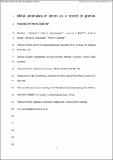Files in this item
Metal anomalies in zircon as a record of granite-hosted mineralization
Item metadata
| dc.contributor.author | Gardiner, Nicholas J. | |
| dc.contributor.author | Hawkesworth, Chris J. | |
| dc.contributor.author | Robb, Laurence J. | |
| dc.contributor.author | Mulder, Jacob A. | |
| dc.contributor.author | Wainwright, Ashlea N. | |
| dc.contributor.author | Cawood, Peter A. | |
| dc.date.accessioned | 2022-10-15T23:39:53Z | |
| dc.date.available | 2022-10-15T23:39:53Z | |
| dc.date.issued | 2021-12-20 | |
| dc.identifier | 276341194 | |
| dc.identifier | a720380b-3b00-4170-9cd2-0e4b67085447 | |
| dc.identifier | 85117602106 | |
| dc.identifier | 000712225100008 | |
| dc.identifier.citation | Gardiner , N J , Hawkesworth , C J , Robb , L J , Mulder , J A , Wainwright , A N & Cawood , P A 2021 , ' Metal anomalies in zircon as a record of granite-hosted mineralization ' , Chemical Geology , vol. 585 , 120580 . https://doi.org/10.1016/j.chemgeo.2021.120580 | en |
| dc.identifier.issn | 0009-2541 | |
| dc.identifier.other | RIS: urn:EA1D295AD101ED6626A6CC5B031CBBFB | |
| dc.identifier.other | ORCID: /0000-0003-3465-9295/work/101959013 | |
| dc.identifier.uri | https://hdl.handle.net/10023/26197 | |
| dc.description | Funding: This work was supported by Australian Research Council grant FL160100168 (NJG, ANW, JAM, and PAC); Leverhulme Trust RPG-2015-422 and EM-2017-047\4 (CJH). LJR acknowledges the support of the DSI-NRF Centre of Excellence for Integrated Mineral and Energy Resource Analysis (DSI-NRF CIMERA), at the University of Johannesburg, towards this research. | en |
| dc.description.abstract | Granite-hosted magmatic-hydrothermal mineral deposits are major sources of Cu, Mo, Sn, Li, and W, originating via mineralizing fluids exsolved from volatile-saturated magmas. We show how trace elements in zircon sampled from the granite-hosted Zaaiplaats tin deposit, Bushveld Complex, preserve a record of both the enrichment of incompatible metals during magma fractionation and those arising from magmatic-hydrothermal mineralization processes. The Zaaiplaats granites are subdivided into three groups; mineralized, altered, and unmineralized. Zircon trace element contents define two trends in a plot of Sn against Gd: Sn/Gd ratios in zircons from the unmineralized samples, as well as the majority of altered samples, define a magma fractionation trend with increasing Y at constant Sn/Gd, whereas those from the mineralized samples are displaced to high Sn/Gd ratios at similar Y. Elevated Sn in the Zaaiplaats zircons is attributed to the introduction of a Sn-rich mineralizing fluid during zircon growth, which occurred at an advanced stage of crystallization (>85%) of the host magma. This model is consistent with the preservation of whole-rock Sn zonation in the Zaaiplaats granites modelled by closed-system magma differentiation and the ensuing exsolution of an acidic, saline Sn-rich magmatic-hydrothermal fluid (Groves and McCarthy, 1978). A metal anomaly, Sn/Sn*, is defined which describes the deviation of Sn over that expected through magma fractionation alone (Sn*), and arises from Sn mobilization due to magmatic-hydrothermal mineralization processes. Identification of metal anomalies such as Sn/Sn* and Cu/Cu* in mineral archives or at the whole-rock level, provides an empirical link to the onset of mineralization processes in magmatic-hydrothermal systems, and can be coupled with geochemical proxies to yield a better understanding of the conditions leading up to, and subsequent to, volatile saturation. | |
| dc.format.extent | 9200582 | |
| dc.language.iso | eng | |
| dc.relation.ispartof | Chemical Geology | en |
| dc.subject | Zircon trace elements | en |
| dc.subject | Granite hosted mineralization | en |
| dc.subject | Tin tungsten Sn W Li critical metals | en |
| dc.subject | Bushveld complex | en |
| dc.subject | Porphyry deposits | en |
| dc.subject | Hydrothermal fluids | en |
| dc.subject | QE Geology | en |
| dc.subject | QD Chemistry | en |
| dc.subject | DAS | en |
| dc.subject | AC | en |
| dc.subject.lcc | QE | en |
| dc.subject.lcc | QD | en |
| dc.title | Metal anomalies in zircon as a record of granite-hosted mineralization | en |
| dc.type | Journal article | en |
| dc.contributor.institution | University of St Andrews. School of Earth & Environmental Sciences | en |
| dc.identifier.doi | https://doi.org/10.1016/j.chemgeo.2021.120580 | |
| dc.description.status | Peer reviewed | en |
| dc.date.embargoedUntil | 2022-10-16 |
This item appears in the following Collection(s)
Items in the St Andrews Research Repository are protected by copyright, with all rights reserved, unless otherwise indicated.

